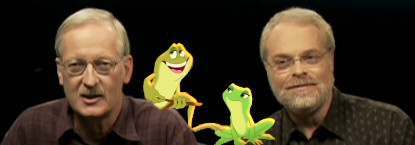Q: This is a return to 2-D animation for Disney. Is there anything new with the technology this time around?
John Musker: Our "ink and paint" system was different. We used "Harmony" instead of CAPS, our old system that had been mothballed. With this new system, we were able to evaluate scenes in full color and do paint adjustments to characters without having to repaint entire scenes. We also were able to evaluate all elements "in continuity" which was something new. Our character animation was done on paper just as Snow White was. Our effects animation, i.e., the water ripples, magic, shadows, etc., for the first time was done without paper. Those elements were drawn on a pressure-sensitive tablet with a stylus.
UltimateDisney.com: How was it to be back at Disney with former colleagues after time away?
John Musker: It was great fun. These artists are the best in the world and we felt privileged to see them do what they do better than anyone else. We also worked with some young kids right out of art school and that was fun, too. They had a lot of youthful exuberance and were mentored by the vets.

Q: Originally, The Princess and the Frog was going to be set in Chicago and be CG-animated, how did setting it in New Orleans and making it hand-drawn come about?
Ron Clements: A few years ago, Pixar had explored a version of The Frog Prince set in gangland Chicago. John Lasseter wanted to switch the locale to New Orleans, a city he loves, but the project was eventually shelved. Meanwhile Disney had explored various versions of The Frog Prince going all the way back to the time of Beauty and the Beast. In 2006, Disney bought the rights to a book called The Frog Princess, which was the fairy tale with a twist: when the Princess kissed the frog, she turned into a frog as well.
When John Lasseter was put in charge of Disney animation in February 2006, he asked John and me to take a look at all the previous versions and come up with our own. We combined the New Orleans setting with the twist, added some new characters and pitched a take that became the basis for the movie.
UltimateDisney.com: What were some of your biggest influences on this film? Did you look back to past movies at all for guidance?
John Musker: Bambi and Lady and the Tramp were two big influences in terms of background styling. The painterly lush look of Bambi influenced our bayou scenes and our New Orleans French Quarter cityscapes were influenced by Lady and the Tramp. We were also influenced by the great draftsmanship displayed in the character drawing in Lady. The characters were drawn with a great deal of solidity. Later films like Sleeping Beauty got more designy and stylized. We wanted a more dimensionally drawn look.
Ron Clements: We also did a lot of research in New Orleans itself. We went to the Jazz Fest, toured the French Quarter and the Garden District, spent a day with a Voodoo priestess and toured the bayou with a Cajun tour guide. We also got to ride a float during Mardi Gras. All of this stuff found its way into the movie.
Q: The magical elements of this film are decidedly underplayed compared to past Disney fairy tales -- Mama Odie does not give our heroes a powerful talisman nor step in to save the day, while Dr. Facilier and his superiors are much less dark and foreboding than their villainous predecessors. How did you set about breaking these story elements?
John Musker: In earlier versions of our story, Mama Odie gave our heroine some gris-gris, herbal charms that got "energized" in the climax. We wound up rewriting that as our gris-gris felt like a bit of a deus ex machina. We do think of Facilier and his shadows as scary and were not trying to soft-pedal that. Some of his scariness we thought of as "funhouse" scary and not slasher film scary.
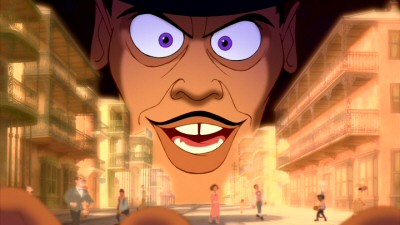
Ron Clements: Mama Odie was based on Ava Kay Jones, an ordained Voodoo Priestess who we met with in New Orleans. She told us that even though magic is part of the Voodoo religion, when people come to someone like her for help, she advises them to never use magic to solve their problems. That almost always backfires. Rather they should look inside themselves for the answers. Dr. Facilier was based on the New Orleans "Bokor". People who've broken away from the religion, made pacts with dark Voodoo spirits, and sell their magic for money. In terms of scariness, I think Facilier was handled similarly to our other villains like Ursula, Jafar, and Hades. We like scary stuff, but don't want to go too far. Some people thought Facilier was too scary.
You think he's not scary enough? Maybe that means we got it about right.
Q: Randy Newman's score lends itself beautifully to both the location and time period. Was he the first composer you had in mind for the film, and at what point in the production did he begin developing the music?
Ron Clements: We pitched the idea for this movie to John Lasseter in March of 2006. We pitched it as a hand-drawn film with an African American heroine, and as a musical with Randy Newman doing the music. John said yes to all those things. We thought of Randy almost immediately because his music is iconic, classic Americana, and we knew he spent his boyhood summers growing up in New Orleans. We met with Randy the following May, took him through the story, and talked about the placement of songs and styles of music. Randy took to the project immediately. He hadn't written many musicals before but he was a great collaborator and we were thrilled with his brilliant work.
John Musker: Randy was our first and only suggestion to John Lasseter to do the music. We did "idea" storyboards full of visual ideas for Randy to react to. We wrote the script without songs but knowing where they might fall. Randy then wrote songs that in some cases absorbed some of our dialogue. Randy's writing of Facilier's song, in which he gave him several sardonic asides, influenced us to try and put that quality and tone into his other non-musical scenes as well. He wrote the songs over the course of a year and a half as we animated the movie, although we would always animate the song after he had written and recorded it (in animation, voices are recorded before animation, not dubbed in later). Likewise with the music we animate after the recordings and try and exploit things we hear in the music track.
Q: I had the pleasure of interviewing Ray's animator Mike Surrey a few months back. He said Jim Cummings made his job easy. What made you choose him for Ray? Also, what about Keith David and the relatively unknown Jennifer Cody?
John Musker: We found Jen Cody when we did auditions in NYC. She has done work on Broadway. When we heard her voice, we thought she had a very distinctive appealing sound that was part Jean Arthur, part Bernadette Peters, with a nod to Betty Boop. Jim Cummings was a riot to work with. We have worked with him in the past but what we didn't know was that he had spent years in New Orleans where he worked alongside Cajuns whose speech patterns he picked up. He was and is a great improviser and he came up with great lines on the fly as it were. Keith, we had worked with on Hercules. We knew he had that amazing speaking voice. We didn't know he could sing as well, and he auditioned for us and sang like Nat King Cole. He was a joy to work with.
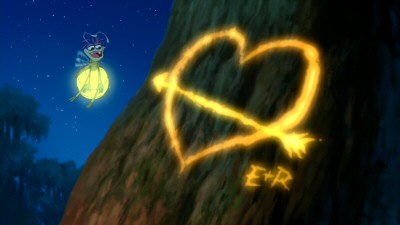
Q: Being a Louisiana native, it's eerie and extremely entertaining how well you got the Cajun character down. Was there a lot of research involved in Raymond and the film as a whole?
John Musker: We wanted to do right by Louisiana and the culture there including the great Cajun populace. John Lasseter really wanted authenticity, so we took several trips down there. We met with a number of people including a man named Reggie who was our bayou tour guide. We noted his speech patterns, and picked up more phrases at jazz Fest. We also did research where we read stories written in a "Cajun" voice and found Cajun glossaries online. Best of all though, we cast Jim Cummings as our firefly. When he auditioned, he did a great Cajun accent and we learned he had a home there for several years and had worked with Cajuns in the Merchant marines.
He was able to improvise in his Cajun speak, so he added a lot of flavor to our gumbo.
Q: In talking to animator Mark Henn, he said an employee at Disney was used as the model for Tiana. Who is she? What can you tell us about her?
John Musker: Jaimie Milner was an intern in post-production (she attended USC), a beautiful girl with beautiful hair whom we took some photos of for reference. She was also influenced certainly by Anika Noni Rose, the voice, who gave Tiana her dimples and her left-handedness.
Q: Where did the inspiration for Louis come from?
John Musker: Louis Armstrong the great jazz trumpeter was the inspiration.
Q: Can you talk about the difficulty of making a fairy tale happy ending feel earned and not contrived?
John Musker: We wanted our ending to be both surprising and satisfying. We hoped that people would believe that Tiana and Naveen, happy to have found and fallen for each other, were willing to accept their "frog" status as long as they had one another. We thought the twist of them turning back into frogs with their kiss, which we first saw in an early treatment by Greg Erb and Jason Oremland, before we ever got on the project, was clever and worked it into our script as well.
Q: In one scene, King Triton rolls past on a Mardi Gras float in an obvious reference to The Little Mermaid. There are dozens of less obvious references to other Disney movies like Aladdin, The Lion King, Pete's Dragon, The Jungle Book, and even Pirates of the Caribbean. Was this a conscious collective homage, or are those classics so much a part of everyone's consciousness that they just sort of crept in?
Ron Clements: Almost all this stuff was deliberate and done for our own amusement. Actually most of the Mardi Gras floats are based on movies John and I worked on. Along with the "Mermaid" float, there are brief shots of an "Arabian Nights" float, a Greek mythology float, and a "pirate" float. There are also caricatures of John and I on the mermaid float throwing beads to the crowd. There are many other caricatures of people who worked on the movie that pop up throughout. Many other Disney references as well. We don't want any of this stuff to be distracting. Just a little something extra for whoever may catch it.
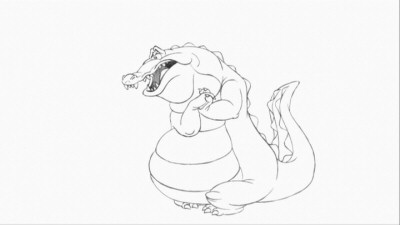
Q: There seem to be a lot of similarities between Ariel in The Little Mermaid and Tiana, in the way that they both want something more with their lives. How do you see the two in comparison?
John Musker: Ariel never lacked for a sense of fun, as she explored sunken ships and collected her artifacts. Tiana's sense of fun got left behind in her single-minded pursuit of her restaurant.
Q: There have obviously been films that have covered the same ground before. How do you make sure not to fall into some of those conventions set by those previous films to the point where it feels predictable or formulaic?
Ron Clements: John and I really hadn't done a fairy tale since The Little Mermaid twenty years ago. It was interesting for us to re-examine this stuff from a different perspective. From the beginning, we thought of Tiana as someone who would never have been a big fan of Disney fairy tales.
Our attempt was to take a lot of the archetypal elements of these films (the Prince's loyal manservant, the fairy Godmother, the wishing star, death and resurrection, etc.) and add some kind of twist to them. But, we were always thinking of this as a kind of retro film, trying to recapture a bit of what Disney magic means to us.
Q: In the grand Disney tradition, was the multi-plane camera system used to blend the characters into the layered background?
John Musker: Our compositing was done in the computer. Our layout people designed backgrounds to have out of focus foreground elements like the multi-plane camera. The opening shot of the mansion had foreground trees that were out of focus. The effect is the same as the multi-plane. The establishing shot of Mama Odie's tree had a multi-plane effect.
Q: What advice could you give students interested in animation?
John Musker: Learn how to draw, even if interested in CG animation. It's the basis of what we do. Keep a sketchbook. Try making a very simple little film. Try and tell a story clearly and entertainingly. Study the way people move and animate move. Observe all you can, and try and capture that simply in a few lines on paper.
Q: Given the success you two have had in the past and that this was the first traditional animated feature in five years for Disney, did you feel a great sense of pressure/expectation from John Lasseter or yourselves?
Ron Clements: John Lasseter was always very supportive and never put any extra pressure on us. But yes, we felt a lot of pressure. We knew the stakes were high on this movie in all kinds of ways. We just tried not to think about that too much and attempted to make the best movie we possibly could.
Q: "Almost There" was very striking and really stood out. Can you talk about the influences for that sequence?
John Musker: The styling was based on the great Harlem renaissance artist Aaron Douglas. Sue Nichols Maciorowski, a wonderful visual development artist, brought his work to our attention.
Q: Can you explain how the two main characters could talk to animals and humans at the same time while they were frogs?
John Musker: It was our "rule" that since they were transformed humans they could still speak and understand humans. But because they are frogs, they can also understand and be understood by animals. we tried to set this up when after they became frogs, Stella the dog, heretofore heard only as barks, actually spoke.
Q: Where do you feel The Princess and the Frog fits into both of your resumιs?
John Musker: The return of hand-drawn animation,
done at the highest level of quality.
Q: Talk about Oscar night. What was that like for you?
John Musker: It was sort of like Sioux City on steroids.
Q: Do either of you have a favorite special feature on this DVD or Blu-ray?
John Musker: [Blu-ray] viewers can see the entire film in rough animation. I think that's very special and will be a treat for the consumer to discover.
John Musker: Thanks for so many questions. I just type too #$@% slow! This is because my poor Irish Mom typed all my term papers in high school. Let this be a lesson to all you young people. Learn to type. See you at the movies!!
Ron Clements: Thank you, everybody! We had fun!
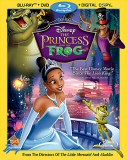
The Princess and the Frog comes to DVD and Blu-ray next Tuesday.
Read our review. Buy it from Amazon.com: Blu-ray/DVD/Digital Copy combo / DVD / Blu-ray
